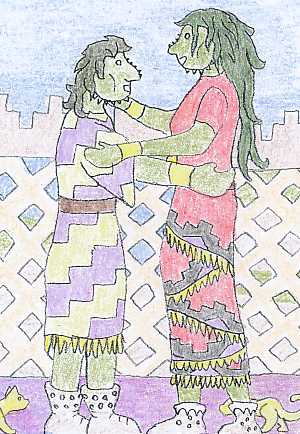Gobíls
Gobíls1 are one of the most prominent sapient species of the Múlíat Mountains and the Sjorg Desert in southern Dragonía, and were among the first to appear along with the Alalaríans in the western woodlands, and the Brariians in the central part of the continent.
One of the most striking features on Gobíls are the small, bony protrusions along their jawline and nose, which vary somewhat between different groups and individuals, from blunt knobs to sharp spikes. Their skin is leathery and dry, since it has very few sweat glands, and instead regulate their temperature by panting, and is of various shades of green, with olive green being the most common.
Gobíls have coarse, black or dark-green hair which grays with age, and men grow beards in the form of several tufts between the jaw spikes. The eyes are deep-set to shield them from harsh sunlight, with pink, violet or brown iris, and have a translucent third eyelid to protect them against dust and sand. Gobíls have thin lips, and can close their nostril to avoid inhaling dust during storms.
Their digestive system is much stronger than those of most people in Dragonía, and thus are able to consume rotten meat and fish without becoming sick, so Gobíls have rather different ideas than most about when food becomes spoiled.
Around 15.000 b.Dr, these southern tribes eventually expanded into the region of Darlaa in the western part of the Múlíat Mountains, and gradually established a series of city-states in the region through numerous wars with the different native peoples there. The Gobíls inhabiting Darlaa became known as Kóhans and the hunters who remained to the north Hrens, while those who expanded into Dakrúzú Peninsula further to the south are called Traks.
Kóhans began settling the Sjorg Desert to the west in several waves after 7000 b.Dr, collectively referred to as Krekkúxes, most of whom were eventually conquered and enslaved around 4.500 b.Dr by the Óraxes, a Kóhan tribe banished to the desert after being defeated by the Znagrúks. The Órax Empire was the largest Gobíl state in the history of Dragonía, and lasted until 15 a.Dr, when a series of massive slave revolts reduced it to three cities along the coast of Súrkniss Sea.
Appearance and abilities
Appearance and behaviour
Gobíls are carnivorous humanoids, who -aside from Hrens- are generally taller than Útels and Mörkels as well as physically stronger and faster, and able to survive longer without water. The women are notably larger, stronger and often more aggressive than the men, which is why matriarchy is the norm among Gobíls.One of the most striking features on Gobíls are the small, bony protrusions along their jawline and nose, which vary somewhat between different groups and individuals, from blunt knobs to sharp spikes. Their skin is leathery and dry, since it has very few sweat glands, and instead regulate their temperature by panting, and is of various shades of green, with olive green being the most common.
Gobíls have coarse, black or dark-green hair which grays with age, and men grow beards in the form of several tufts between the jaw spikes. The eyes are deep-set to shield them from harsh sunlight, with pink, violet or brown iris, and have a translucent third eyelid to protect them against dust and sand. Gobíls have thin lips, and can close their nostril to avoid inhaling dust during storms.
Their digestive system is much stronger than those of most people in Dragonía, and thus are able to consume rotten meat and fish without becoming sick, so Gobíls have rather different ideas than most about when food becomes spoiled.
Arcane abilities
Like most inhabitants of southern Dragonía, Gobíls -especially those in the Sjorg Desert and on the Dakrúzú Peninsula- are mostly affected by the element of Fire, and their mages (commonly known as hláans2) are able to burn anything they touch, manipulate the shape and intensity of fires, and sense volcanic activity, while simultaneously being somewhat resistant to burns.History
Gobíls first appeared in the northern Múlíat Mountains around 50.000 b.Dr, during the last ice age, where they subsisted primarily on hunting and fishing. As ice age ended and the climate gradually became warmer and more arid, prey became less plentiful, which caused the southern tribes to adopt a pastoralist lifestyle in order to defend some of the herds from rivals, giving rise to more complex societies. These early societies are known as Proto-Gobíls.Around 15.000 b.Dr, these southern tribes eventually expanded into the region of Darlaa in the western part of the Múlíat Mountains, and gradually established a series of city-states in the region through numerous wars with the different native peoples there. The Gobíls inhabiting Darlaa became known as Kóhans and the hunters who remained to the north Hrens, while those who expanded into Dakrúzú Peninsula further to the south are called Traks.
Kóhans began settling the Sjorg Desert to the west in several waves after 7000 b.Dr, collectively referred to as Krekkúxes, most of whom were eventually conquered and enslaved around 4.500 b.Dr by the Óraxes, a Kóhan tribe banished to the desert after being defeated by the Znagrúks. The Órax Empire was the largest Gobíl state in the history of Dragonía, and lasted until 15 a.Dr, when a series of massive slave revolts reduced it to three cities along the coast of Súrkniss Sea.
1Original icelandic: Gobílar, singular: Gobíli.
2Hláar, singular: hlái.
Origin/Ancestry
Northern Múlíat Mountains
Related Organizations
Related Ethnicities




Comments